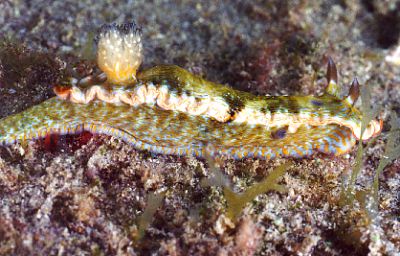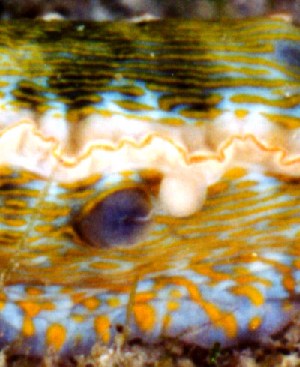Hypselodoris sp. 4 - Post Mating
May 16, 2003
From: Linda Ianniello


Note added 31 May 2010: This species has recently been named H. juliae.
Dr. Bill,
I am probably going to blush when you post the answer to this question, but attached are 2 photos of a Hypselodoris sp. 4 after mating. What is the "bead" that is visible dangling by a "thread" from its "organ"? After mating, neither slug proceeded to lay eggs - they both headed back to their food sponge which was a couple of feet away.
Also, I sent in a picture some time ago of eggs laid by this species in a clump of algae. It was the only time I had seen eggs, even though we see the slugs frequently. This past weekend I found more eggs, laid in the same type of algae, about 1.5 feet from their blue sponge food. It is interesting that they don't appear to lay their eggs on or near their food, but in that particular algae, where they are not very visible even though they are a very bright color.
Regards,
Linda I.
Lindai@us.ibm.com
Ianniello, I., 2003 (May 16) Hypselodoris sp. 4 - Post Mating. [Message in] Sea Slug Forum. Australian Museum, Sydney. Available from http://www.seaslugforum.net/find/9870Thanks Linda,
It would be interesting to build up some information on where different species lay their eggs. Certainly those with direct development often lay their eggs on their food which I guess means that the small juveniles can crawl out of their egg capsule straight on to the dinner table. A very usful adaptation if your are very small.
Concerning the white 'bead' in the second photo - I hope I can be delicate enough to save you a blush. It looks very much like a compacted bundle of sperm from one of the two sperm sacs these animals have. We don't know much about the mechanics of mating in opisthobranchs so anything I say from now on I am making up. I remember reading recently about mating in the garden snail Helix aspersa - native to Europe and an introduced pest in many other parts of the world. Like sea slugs, land snails are also hermaphrodites, so a comparison with t hem is nnot so out of place. Heliz aspersa is one of a number of snails tha stab their partner during mating with a calcareous dart - often called a 'love dart'. The function of this dart remains a mystery, but one recent suggestion is that it stimulates muscle contractions which cause sperm from earlier matings to be expelled from the snail, so that the sperm of the present partner does nnot have to compete with sperm from earlier matings. Whether this nice theory can be shown to be the case or not, it does raise the possibility that if this is a ball of sperm, it has been expelled by the slug for some reason.
Best wishes,
Bill Rudman
Related messages
-
Hypselodoris juliae from Brazil [2]
From: Peter Wirtz, June 3, 2010 -
Hypselodoris juliae from Brazil [1]
From: Vinicius Padula, May 31, 2010 -
Hypselodoris sp. 4 eggs
From: Linda Ianniello, September 27, 2002 -
Food of Hypselodoris sp. 4
From: Anne DuPont, October 6, 2001 -
Re: Hypselodoris sp. 4 from Florida
From: Linda Ianniello , October 5, 2001 -
Food of Hypselodoris sp. 4
From: Anne Dupont, September 25, 2001 -
Hypselodoris acriba or H. edenticulata?
From: Anne DuPont, September 25, 2001 -
Hypselodoris acriba or H. edenticulata
From: Anne DuPont, August 21, 2001
